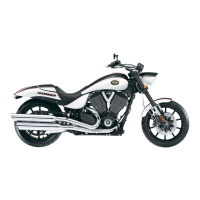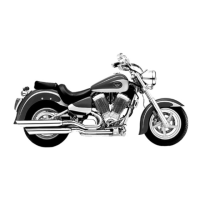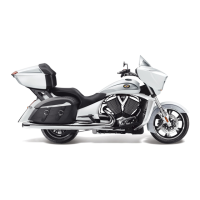
Do you have a question about the Victory Motorcycles 2009 Hammer and is the answer not in the manual?
| Brand | Victory Motorcycles |
|---|---|
| Model | 2009 Hammer |
| Category | Motorcycle |
| Language | English |
Essential guidelines for safe operation and accident prevention.
Maximum weight limits for safe handling and stability.
Guidelines for securely attaching and distributing cargo for stability.
Safety precautions for handling fuel and avoiding exhaust gas hazards.
Procedure for reporting vehicle defects to authorities.
Identification of controls and instruments on the handlebars.
Unique number for vehicle registration, insurance, and parts.
Overview of speedometer, tachometer, and indicator lamps.
Explains the function of warning and status indicator lights on the dashboard.
Operation of switches and levers on the left handlebar.
Operation of switches and controls on the right handlebar.
Procedure to check and maintain the correct engine oil level.
Inspection of tire pressure, condition, and tread depth.
Checks for front and rear brake lever/pedal function and fluid levels.
Inspection of mechanical or hydraulic clutch fluid level and freeplay.
Procedures for properly seating engine parts for optimal performance.
Proper technique for shifting gears for smooth acceleration and deceleration.
Techniques for slowing down and stopping the motorcycle safely.
Instructions for safely parking the motorcycle on various surfaces.
First scheduled service after 500 miles for optimal longevity.
Schedule for regular service and inspection of motorcycle components.
Procedures for changing engine oil and oil filter.
Inspection and adjustment of the drive belt tension and condition.
Maintenance procedures for brake levers, pedals, pads, discs, and fluid.
Information on battery care, charging, and installation.
Steps for cleaning the motorcycle's exterior safely.
Methods to protect and enhance the motorcycle's finish and components.
Using fuel stabilizer for long-term storage.
Maintaining battery health during storage periods.
Steps to prepare the motorcycle after a storage period.
Details on warranty coverage for emissions-related components.
Owner's obligations for maintaining warranty coverage.
Exclusions and limitations of the warranty terms.
Physical measurements of the motorcycle.
Technical details of the motorcycle's engine specifications.
Specifications for wheels, tires, and related components.
Recommended fuel types and octane ratings.
Location and importance of the VIN.
Location and importance of the engine identification number.








